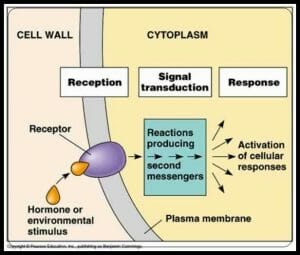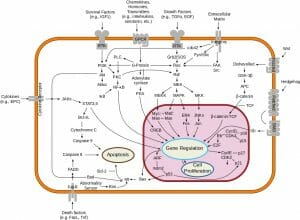Signal Transduction Definition
Signal transduction is the process of transferring a signal throughout an organism, especially across or through a cell. Signal transduction relies on proteins known as receptors, which wait for a chemical, physical, or electrical signal. Chemical signals are called ligands, and can be produced by organisms to control their body or received from the environment. Regardless of which type of signal, it must be transferred throughout the body and across cell membranes. This process is known as signal transduction. A generalized image of signal transduction can be seen below.
Receptor proteins are specialized by the type of cell they are attached to. Each type of cell receives different signals from the body and environment, and must be specialized so that the body can produce a specific and coordinated response. Each of these specialized proteins has a special method of transferring a signal into the cell. Some proteins activate other molecules, called second messengers, which carry the message to the nucleus or other organelles. Other proteins use the energy from ATP to activate enzymes, which carry out metabolic reactions. The different routes which signal transduction takes to carry a signal are known as signal transduction pathways.
Signal Transduction Pathway
During signal transduction, a signal may have many components. There is the primary messenger, which may be a chemical signal, electrical pulse, or even physical stimulation. Then, the receptor protein embedded in the cellular membrane must accept the signal. Upon receiving the signal, this protein goes through a conformational change. This changes its shape and thus, how it interacts with the molecules around it.
The many different receptor proteins act in different ways. Above is a simple representation of the many different signal transduction pathways in mammals. Do not be overwhelmed by the complexity of the drawing. The important thing to realize is that all of these signal transduction pathways contain the same elements. A signal is received by a receptor protein, and the protein transfers the signal through the cell membrane and into the cell. The kinds of receptors and the second messengers they create can be very different. This is based on the action which the signal must stimulate. There are some examples in the next section which will help shed light on the many differences and similarities between pathways.
Examples of Signal Transduction
Touch and Vision
The signal transduction pathway of touch and vision works in the same way that many nerve signals do. Instead of creating a second messenger or processing a signal internally, the stimulation of the receptor protein causes an influx of ions into the cell. This causes the cell membrane to depolarize. A normal cell membrane is polarized, or has a voltage potential across it. This voltage potential is created by the cell actively pumping ions out of the cell. Because ions are charged, by building them up in placed, a voltage can be created. When only one receptor protein is stimulated, only a small section of the membrane depolarizes.
But when you receive a strong signal, such as pressing your finger against a surface or seeing a bright light, the entire membrane of many cells is depolarized at the same time. This event triggers an action potential, which is how the signal travels down a nerve. This is caused by a series of other receptor proteins which are sensitive to the change in voltage. Upon feeling the voltage change, they too allow the ions to even out, which sends the signal down the cell.
Upon reaching the end of the first cell, the signal must cross a synapse to another nerve cell. To do this, another signal transduction pathway is used. As the action potential reaches the end of the first cell, specialized receptor proteins receive the signal, and trigger the release of neurotransmitters. These small ligands travel across the space between cells by diffusing through the fluid, and arrive at receptor proteins on the next cell. These receptors are also gated ion channels, and upon activation cause another action potential in the next nerve. In this way, a signal can travel from your finger or eye to your brain in a matter of microseconds.
Hormones
Unlike touch and vision, hormones are signals that your body creates to regulate itself. Hormones can cause the body to do many different things, and they themselves are often triggered by a separate signal transduction pathway.
Typically, a hormone is release from an endocrine gland, such as the thyroid or pancreas. These hormones control everything from metabolism to growth. The signals they transmit are almost always transmitted through a ligand-receptor signal transduction pathway. Reproductive organs also release hormones, which function to prepare the body for reproduction. They operate in a similar manner, discussed below.
Upon being triggered to release hormone, the cells in endocrine glands will release their stored hormone, which they have spent time building up. They do this by forcing vesicles full of the hormone to merge with the cell membrane, spilling the hormone into the intracellular space. Capillaries, or tiny blood vessels, run through this space. The hormone dissolves into the bloodstream, where it can be carried around the body.
Certain cells have specific receptors, which can activate different pathways upon receiving a signal. For instance, the hormone insulin can cause muscle cells to uptake and store glucose, whereas it will cause liver cells to stop producing glucose. This helps regulate the total amount of glucose in the blood. The receptors in these different tissues both accept insulin as a ligand, but the signal transduction pathway is different. One pathway stimulates a cellular process in the muscle cells which increases the number of glucose transporters in their cell membrane. The other signal transduction pathway in the liver turns off a key enzyme which is required to produce glucose.
Quiz
1. Which of the following is NOT an example of signal transduction?
A. A molecule found in blood binds to a protein in a shark’s olfactory cells. A signal is sent to the brain.
B. Cow’s milk contains growth hormones. Upon receiving these hormones, a baby cow’s cells grow and divide.
C. A cell uses the energy for a molecule of glucose to drive other reactions.
2. Why is it necessary that different cell types have different receptors for the same ligand or hormone?
A. Different cells need to react in different ways
B. It is not necessary
C. The different receptors receive different types of ligand
3. A certain species of plant in the Australian outback has created an interesting defense with signal transduction pathways. When herbivores feed on it, it releases a gas into the air. The gas reaches neighboring plants, stimulating receptors which cause the cells of those plants to produce toxins. Which mammalian defense is this most similar to?
A. A mouse biting a predator to escape
B. Prairie dogs calling to each other when a hawk is above
C. A skunk releasing a toxic odor upon being attacked
References
- Lodish, H., Berk, A., Kaiser, C. A., Krieger, M., Scott, M. P., Bretscher, A., . . . Matsudaira, P. (2008). Molecular Cell Biology (6th ed.). New York: W.H. Freeman and Company.
- McMahon, M. J., Kofranek, A. M., & Rubatzky, V. E. (2011). Plant Science: Growth, Development, and Utilization of Cultivated Plants (5th ed.). Boston: Prentince Hall.
- Nelson, D. L., & Cox, M. M. (2008). Principles of Biochemistry. New York: W.H. Freeman and Company.
Signal Transduction


No comments:
Post a Comment